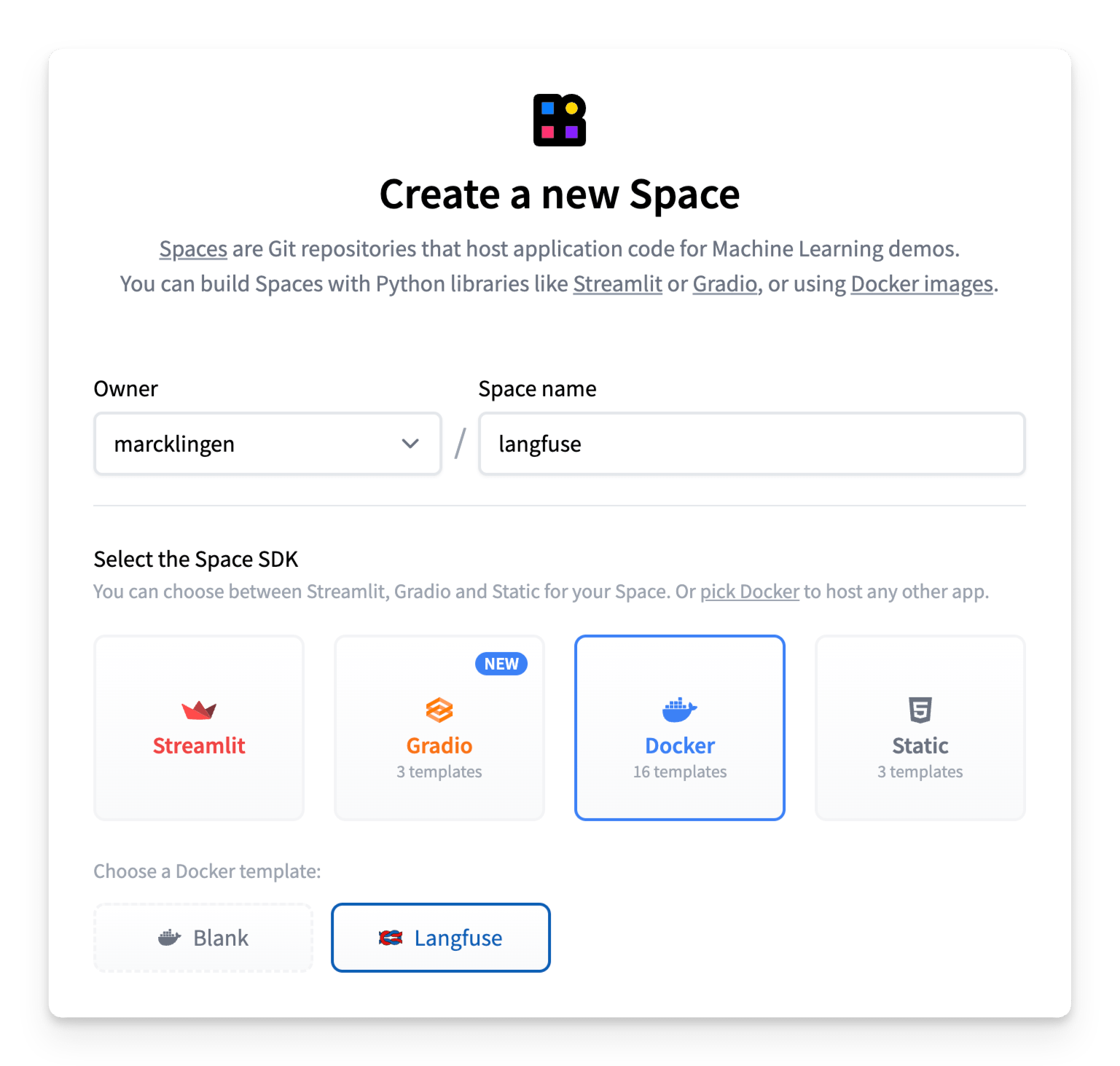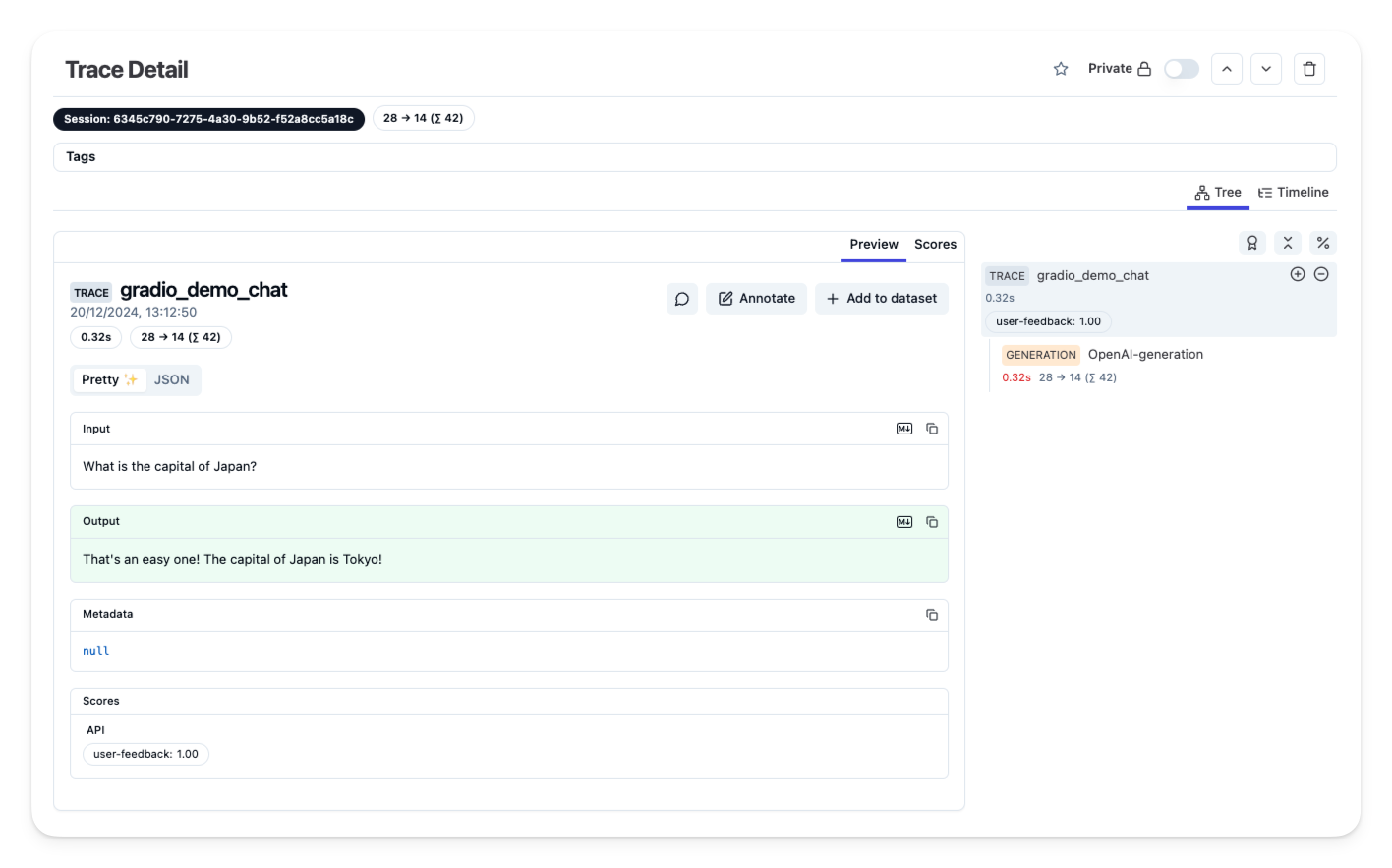-
Notifications
You must be signed in to change notification settings - Fork 374
docs: langfuse on spcaes guide and gradio example #1529
New issue
Have a question about this project? Sign up for a free GitHub account to open an issue and contact its maintainers and the community.
By clicking “Sign up for GitHub”, you agree to our terms of service and privacy statement. We’ll occasionally send you account related emails.
Already on GitHub? Sign in to your account
Merged
andrewrreed
merged 30 commits into
huggingface:main
from
jannikmaierhoefer:langfuse-spaces-example
Jan 7, 2025
Merged
Changes from 23 commits
Commits
Show all changes
30 commits
Select commit
Hold shift + click to select a range
7496fef
docs: langfuse on spcaes guide and gradio example
jannikmaierhoefer 0fffbdb
edit toctree
jannikmaierhoefer fcc7485
text edit
jannikmaierhoefer 82e3972
edit troubleshooting part
jannikmaierhoefer f024ddc
edit text
jannikmaierhoefer 41dfe8a
update numbers
jannikmaierhoefer ac70405
fix spelling
jannikmaierhoefer 8462e6f
Update docs/hub/spaces-sdks-docker-langfuse.md
jannikmaierhoefer ad18cdd
Update docs/hub/spaces-sdks-docker-langfuse.md
jannikmaierhoefer a0dfd6e
Update docs/hub/spaces-sdks-docker-langfuse.md
jannikmaierhoefer 112e7e9
Update docs/hub/spaces-sdks-docker-langfuse.md
jannikmaierhoefer 35f25b3
Update docs/hub/spaces-sdks-docker-langfuse.md
jannikmaierhoefer 19dc6c0
Update docs/hub/spaces-sdks-docker-langfuse.md
jannikmaierhoefer 737301c
move troubleshoot section to gradio template readme as this is only g…
jannikmaierhoefer 4c74941
Update docs/hub/spaces-sdks-docker-langfuse.md
jannikmaierhoefer 9849195
edit gradio link name
jannikmaierhoefer 9336d5d
Apply suggestions from code review
andrewrreed 192fb20
fix setup steps numbered list formatting
andrewrreed b1a5a3d
Add simple tracing example with HF Serverless API
andrewrreed 0ca2049
remove <tip> for link formatting
andrewrreed d08059e
point "Deploy on HF" to preselected template
andrewrreed 27485c5
Update docs/hub/spaces-sdks-docker-langfuse.md
andrewrreed fc5070c
include note about HF OAuth
andrewrreed 3b7d39a
add note about AUTH_DISABLE_SIGNUP
andrewrreed 5e976ec
fix tip syntax
andrewrreed cb366e6
alt tip syntax
andrewrreed 42262e0
update note
andrewrreed 345cd96
back to [!TIP]
andrewrreed 5b73543
clarify user access
andrewrreed 1e27b68
minor cleanup
andrewrreed File filter
Filter by extension
Conversations
Failed to load comments.
Loading
Jump to
Jump to file
Failed to load files.
Loading
Diff view
Diff view
There are no files selected for viewing
This file contains hidden or bidirectional Unicode text that may be interpreted or compiled differently than what appears below. To review, open the file in an editor that reveals hidden Unicode characters.
Learn more about bidirectional Unicode characters
This file contains hidden or bidirectional Unicode text that may be interpreted or compiled differently than what appears below. To review, open the file in an editor that reveals hidden Unicode characters.
Learn more about bidirectional Unicode characters
| Original file line number | Diff line number | Diff line change |
|---|---|---|
| @@ -0,0 +1,104 @@ | ||
| # Langfuse on Spaces | ||
|
|
||
| This guide shows you how to deploy Langfuse on Hugging Face Spaces and start instrumenting your LLM application. This integration helps you to experiment on Hugging Face models, manage your prompts in one place and evaluate model outputs. | ||
|
|
||
| ## What is Langfuse? | ||
|
|
||
| [Langfuse](https://langfuse.com) is an open-source LLM engineering platform that helps teams collaboratively debug, evaluate, and iterate on their LLM applications. | ||
|
|
||
| Key features of Langfuse include LLM tracing to capture the full context of your application's execution flow, prompt management for centralized and collaborative prompt iteration, evaluation metrics to assess output quality, dataset creation for testing and benchmarking, and a playground to experiment with prompts and model configurations. | ||
jannikmaierhoefer marked this conversation as resolved.
Show resolved
Hide resolved
|
||
|
|
||
jannikmaierhoefer marked this conversation as resolved.
Show resolved
Hide resolved
|
||
| _This video is a 10 min walkthrough of the Langfuse features:_ | ||
| <iframe width="700" height="394" src="https://www.youtube.com/embed/2E8iTvGo9Hs?si=i_mPeArwkWc5_4EO" title="10 min Walkthrough of Langfuse – Open Source LLM Observability, Evaluation, and Prompt Management" frameborder="0" allow="accelerometer; autoplay; clipboard-write; encrypted-media; gyroscope; picture-in-picture" allowfullscreen></iframe> | ||
|
|
||
| ## Why LLM Observability? | ||
|
|
||
| - As language models become more prevalent, understanding their behavior and performance is important. | ||
| - **LLM observability** involves monitoring and understanding the internal states of an LLM application through its outputs. | ||
| - It is essential for addressing challenges such as: | ||
| - **Complex control flows** with repeated or chained calls, making debugging challenging. | ||
| - **Non-deterministic outputs**, adding complexity to consistent quality assessment. | ||
| - **Varied user intents**, requiring deep understanding to improve user experience. | ||
| - Building LLM applications involves intricate workflows, and observability helps in managing these complexities. | ||
|
|
||
| ## Step 1: Set up Langfuse on Spaces | ||
|
|
||
| The Langfuse Hugging Face Space allows you to get up and running with a deployed version of Langfuse with just a few clicks. | ||
|
|
||
| <a href="https://huggingface.co/new-space?template=langfuse/langfuse-template-space"> | ||
| <img src="https://huggingface.co/datasets/huggingface/badges/resolve/main/deploy-to-spaces-lg.svg" /> | ||
| </a> | ||
|
|
||
| To get started, click the button above or follow these steps: | ||
|
|
||
| 1. Create a [**new Hugging Face Space**](https://huggingface.co/new-space) | ||
| 2. Select **Docker** as the Space SDK | ||
| 3. Select **Langfuse** as the Space template | ||
| 4. Enable **persistent storage** to ensure your Langfuse data is persisted across restarts | ||
| 5. [Optional but recommended] For a secure deployment, replace the default values of the **environment variables**: | ||
| - `NEXTAUTH_SECRET`: Used to validate login session cookies, generate secret with at least 256 entropy using `openssl rand -base64 32`. | ||
| - `SALT`: Used to salt hashed API keys, generate secret with at least 256 entropy using `openssl rand -base64 32`. | ||
| - `ENCRYPTION_KEY`: Used to encrypt sensitive data. Must be 256 bits, 64 string characters in hex format, generate via: `openssl rand -hex 32`. | ||
|
|
||
andrewrreed marked this conversation as resolved.
Show resolved
Hide resolved
|
||
|  | ||
jannikmaierhoefer marked this conversation as resolved.
Show resolved
Hide resolved
|
||
|
|
||
| ## Step 2: Use Langfuse | ||
|
|
||
| Now that you have Langfuse running, you can start instrumenting your LLM application to capture traces and manage your prompts. Your Langfuse Space is pre-configured to use Hugging Face OAuth for secure authentication, so you'll need to authorize `read` access to your Hugging Face account upon first login. | ||
|
|
||
| ### Monitor Any Application | ||
|
|
||
| Langfuse is model agnostic and can be used to trace any application. Follow the [get-started guide](https://langfuse.com/docs) in Langfuse documentation to see how you can instrument your code. | ||
|
|
||
| Langfuse maintains native integrations with many popular LLM frameworks, including [Langchain](https://langfuse.com/docs/integrations/langchain/tracing), [LlamaIndex](https://langfuse.com/docs/integrations/llama-index/get-started) and [OpenAI](https://langfuse.com/docs/integrations/openai/python/get-started) and offers Python and JS/TS SDKs to instrument your code. Langfuse also offers various API endpoints to ingest data and has been integrated by other open source projects such as [Langflow](https://langfuse.com/docs/integrations/langflow), [Dify](https://langfuse.com/docs/integrations/dify) and [Haystack](https://langfuse.com/docs/integrations/haystack/get-started). | ||
|
|
||
| ### Example 1: Trace Calls to HF Serverless API | ||
|
|
||
| As a simple example, here's how to trace LLM calls to the HF Serverless API using the Langfuse Python SDK. | ||
|
|
||
| Be sure to first configure your `LANGFUSE_HOST`, `LANGFUSE_PUBLIC_KEY` and `LANGFUSE_SECRET_KEY` environment variables, and make sure you've [authenticated with your Hugging Face account](https://huggingface.co/docs/huggingface_hub/en/quick-start#authentication). | ||
|
|
||
| ```python | ||
| from langfuse.openai import openai | ||
| from huggingface_hub import get_token | ||
|
|
||
| client = openai.OpenAI( | ||
| base_url="https://api-inference.huggingface.co/v1/", | ||
| api_key=get_token(), | ||
| ) | ||
|
|
||
| messages = [{"role": "user", "content": "What is observability for LLMs?"}] | ||
|
|
||
| response = client.chat.completions.create( | ||
| model="meta-llama/Llama-3.3-70B-Instruct", | ||
| messages=messages, | ||
| max_tokens=100, | ||
| ) | ||
| ``` | ||
|
|
||
| ### Example 2: Monitor a Gradio Application | ||
|
|
||
| We created a Gradio template space that shows how to create a simple chat application using a Hugging Face model and trace model calls and user feedback in Langfuse - without leaving Hugging Face. | ||
|
|
||
| <a href="https://huggingface.co/spaces/langfuse/langfuse-gradio-example-template?duplicate=true"> | ||
| <img src="https://huggingface.co/datasets/huggingface/badges/resolve/main/deploy-to-spaces-lg.svg" /> | ||
| </a> | ||
|
|
||
| To get started, [duplicate this Gradio template space](https://huggingface.co/spaces/langfuse/langfuse-gradio-example-template?duplicate=true) and follow the instructions in the [README](https://huggingface.co/spaces/langfuse/langfuse-gradio-example-template/blob/main/README.md). | ||
|
|
||
| ## Step 3: View Traces in Langfuse | ||
|
|
||
| Once you have instrumented your application, and ingested traces or user feedback into Langfuse, you can view your traces in Langfuse. | ||
|
|
||
|  | ||
|
|
||
| _[Example trace in the Langfuse UI](https://langfuse-langfuse-template-space.hf.space/project/cm4r1ajtn000a4co550swodxv/traces/9cdc12fb-71bf-4074-ab0b-0b8d212d839f?timestamp=2024-12-20T12%3A12%3A50.089Z&view=preview)_ | ||
|
|
||
| ## Additional Resources and Support | ||
|
|
||
| - [Langfuse documentation](https://langfuse.com/docs) | ||
| - [Langfuse GitHub repository](https://github.com/langfuse/langfuse) | ||
| - [Langfuse Discord](https://langfuse.com/discord) | ||
| - [Langfuse template Space](https://huggingface.co/spaces/langfuse/langfuse-template-space) | ||
|
|
||
| For more help, open a support thread on [GitHub discussions](https://langfuse.com/discussions) or [open an issue](https://github.com/langfuse/langfuse/issues). | ||
Add this suggestion to a batch that can be applied as a single commit.
This suggestion is invalid because no changes were made to the code.
Suggestions cannot be applied while the pull request is closed.
Suggestions cannot be applied while viewing a subset of changes.
Only one suggestion per line can be applied in a batch.
Add this suggestion to a batch that can be applied as a single commit.
Applying suggestions on deleted lines is not supported.
You must change the existing code in this line in order to create a valid suggestion.
Outdated suggestions cannot be applied.
This suggestion has been applied or marked resolved.
Suggestions cannot be applied from pending reviews.
Suggestions cannot be applied on multi-line comments.
Suggestions cannot be applied while the pull request is queued to merge.
Suggestion cannot be applied right now. Please check back later.
Uh oh!
There was an error while loading. Please reload this page.